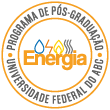Banca de DEFESA: ANA PAULA PEREIRA DA SILVEIRA
Uma banca de DEFESA de DOUTORADO foi cadastrada pelo programa.DISCENTE : ANA PAULA PEREIRA DA SILVEIRA
DATA : 14/05/2020
HORA: 15:00
LOCAL: Por Participação Remota
TÍTULO:
Energy efficiency in water distribution systems - Case Studies analysis in RMSP
PÁGINAS: 227
GRANDE ÁREA: Engenharias
ÁREA: Engenharia Civil
SUBÁREA: Engenharia Hidráulica
ESPECIALIDADE: Hidráulica
RESUMO:
The supply of drinking water is an essential service for any municipality and because it is a highly complex system, it has great demand for electricity, constituting significant expenses for the sanitation companies. Only SABESP (Basic Sanitation Company of the State of São Paulo) is responsible for the consumption of 0.55% of electricity in Brazil. Therefore, there is a need to create and improve energy efficiency projects in the sector due to the fact that energy efficiency and the hydraulic performance of water distribution systems are related. This work aims to analyze the factors that influence energy efficiency in the operation of drinking water distribution through practical cases of water distribution systems in the Metropolitan Region of São Paulo (RMSP). Correlate the consumption of electricity with the reduction of losses and the regularity of water distribution in supply sectors under night demand management regime and in a supply sector with a performance strategy. The study provided strong evidence of the significant impacts of demand variation (flow provided plus losses) on energy-related indicators. Adjusting the pumping operation according to the population's socioeconomic profile and behavior reduces the pumping time and, therefore, electricity consumption. The specific consumption of electricity based on the total water injected into the system reduced by an average of 0.41 kWh/m³ at the beginning of the studies to an average level of 0.37 kWh/m³ at the end of the study; the specific electricity consumption of the distributed water, on the other hand, reduced, on average, in the sectors studied, from 0.71 kWh/m³ to 0.61 kWh/m³ at the end of the study; the actual demand for current water requires less electricity than the amount spent on water pumping stations. Both the total volume of water injected into the water distribution system and the volume of water delivered to customers were used to estimate specific electricity consumption and highlight the remaining opportunity for electricity savings; water losses decreased continuously after the implementation of the measures presented, from an average annual volume of 106,528.75m³ to 90,063.25m³. The average total loss index at the beginning of the study was 365L/connection/day, reducing to 250/ connection/day at the end of the study, which means a reduction of 32%; customer complaints decreased by 31%, when it refers specifically to the results obtained by the implementation of the performance strategy, we have that: the specific electricity consumption of the water injected in the system, presented a reduction of 20%. Regarding the specific electricity consumption of the water distributed, there was a reduction of 37%. The loss rate decreased 53% after the implementation of the performance strategy. Regarding complaints of lack of water, there was a reduction of 61% after implementation. These results show the effectiveness of demand management and the performance strategy in improving energy efficiency.
MEMBROS DA BANCA:
Presidente - Interno ao Programa - 235.788.548-32 - HERLANDER DA MATA FERNANDES LIMA - NENHUMA
Membro Titular - Examinador(a) Interno ao Programa - 1548098 - GILBERTO MARTINS
Membro Titular - Examinador(a) Externo ao Programa - 2357551 - CAMILA CLEMENTINA ARANTES
Membro Titular - Examinador(a) Externo ao Programa - 2197500 - MELISSA CRISTINA PEREIRA GRACIOSA
Membro Titular - Examinador(a) Externo à Instituição - ARIOVALDO NUVOLARI
Membro Suplente - Examinador(a) Interno ao Programa - 1544340 - PATRICIA TEIXEIRA LEITE ASANO
Membro Suplente - Examinador(a) Externo à Instituição - GUSTAVO ADOLFO RONCEROS RIVAS




